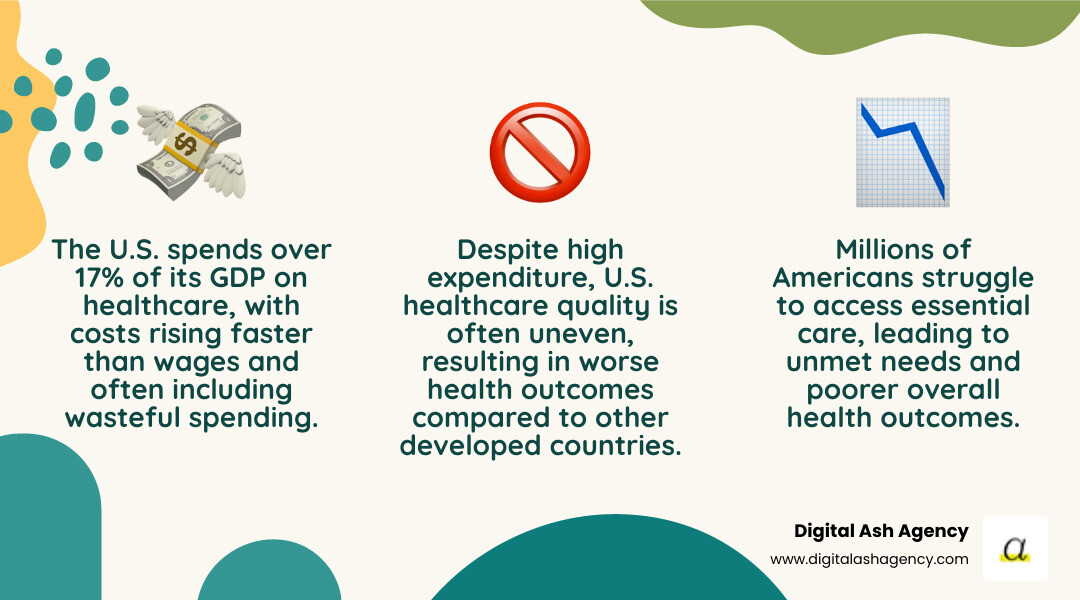
The Urgent Need for Healthcare Change
The U.S. healthcare system is at a crossroads, demanding innovative solutions for healthcare. Despite spending more than any other wealthy nation—about 17% of our GDP—we face significant challenges that require urgent attention.
Here are the top three issues:
- Skyrocketing Costs: A quarter of U.S. healthcare spending is considered wasteful, with costs rising faster than wages and inflation.
- Limited Access: Millions of Americans lack access to essential medical services, leading to poorer health outcomes.
- Uneven Quality: High spending doesn't translate to better results, as the U.S. often lags behind other developed countries in health outcomes.
It's clear that change is necessary. We must find new ways to deliver care that is affordable, accessible, and high-quality. This guide explores how the healthcare industry can transform to meet these needs.
As a branding and marketing expert, I've seen the power of strategic solutions for healthcare firsthand. My experience helps practice owners like you steer tough markets and connect with more patients.

Using Technology: The Digital Revolution in Patient Care
The digital age has ushered in a wave of groundbreaking solutions for healthcare, changing how care is delivered in the U.S. Technologies like Artificial Intelligence (AI), telehealth, and remote patient monitoring are now essential for boosting access and patient engagement. This shift is making care more efficient, personal, and accessible.
Digital health solutions optimize clinical workflows while making care more affordable for patients. Companies like Universal Digital Healthcare (UDHC) demonstrate the power of using cloud computing, big data, and AI to achieve these goals. Technology and healthcare are evolving together, creating exciting opportunities for improvement.

Improved access and patient engagement go hand-in-hand. When patients feel connected and empowered, they take a more active role in their care, leading to better health outcomes. Personalized digital engagement strategies are key. Learn more about how we can help your practice with our insights on More info about our Patient Engagement Methods.
How AI and Automation are Reshaping Diagnostics and Treatment
Artificial intelligence and automation are profoundly reshaping diagnostics and treatment in the U.S. Smart tools like predictive analytics, AI-powered medical imaging, and clinical decision support systems provide doctors with real-time, evidence-based information.
The vast amount of healthcare data available—IQVIA alone processes over 100 billion records annually—fuels these advancements. Companies like HPE use this data for drug findy, personalized medicine, and more accurate diagnoses. Generative AI can process diverse patient data (images, audio, text) to provide deeper insights, allowing clinicians to focus more on patient interaction than data analysis.
Automation also streamlines administrative tasks. For example, AI-powered electronic reporting systems generate medical reports quickly. Trusted resources like UpToDate are also applying Clinical Generative AI to improve decision support. These tools reduce the administrative burden on staff, which helps combat physician burnout and allows professionals to dedicate more time to patients.
Expanding Access with Telehealth and Remote Monitoring
Telehealth and remote patient monitoring are vital solutions for healthcare, expanding access for underserved and rural populations in the U.S. Virtual consultations eliminate barriers like travel time and costs, allowing patients to connect with providers from home. The American Medical Association (AMA) highlights these tools as cost-effective ways to expand capacity and address care disparities.
For private practices, embracing telehealth offers numerous benefits:
- Expanded Reach: Serve patients beyond your physical location, including those in remote areas.
- Patient Convenience: Save patients time and money, leading to higher satisfaction.
- Improved Chronic Disease Management: Use virtual check-ins for proactive care and potentially reduce emergency visits.
- Reduced Overhead: Lower costs associated with large physical office spaces.
- Better Continuity of Care: Maintain regular contact and build stronger patient-provider relationships.
- Provider Flexibility: Offer more flexible scheduling to improve work-life balance.
Telehealth is crucial for bridging the rural-urban divide by connecting communities with specialist care. Leveraging these tools is key to success for any modern practice. Learn more in our guide on More info on Starting a Private Practice with modern tools.
The Power of Data: Driving Smarter Solutions for Healthcare
In an era where solutions for healthcare are powered by information, data is the key to improving patient care. It's about changing vast amounts of information into insights that save lives and money. Big data analytics, interoperability, and robust data management are the cornerstones of modern healthcare.

While Electronic Health Records (EHR) provide the foundation, the real value comes from turning that data into actionable insights. Cloud providers like Amazon Web Services help healthcare organizations process diverse data, from clinical notes to genomics. This data-driven approach supports the shift to value-based care, which rewards quality outcomes over service volume. In this environment, data security is critical for maintaining patient trust.
Leveraging Data Analytics to Improve Outcomes and Reduce Costs
Data analytics is revolutionizing how we manage patient populations by identifying at-risk individuals for early intervention. This proactive approach is central to population health management. For instance, Medecision's Aerial™ portfolio, supporting over 10% of the U.S. population, demonstrates that better health truly starts with better data, improving outcomes while controlling costs.
Analytics helps pinpoint the inefficiencies that contribute to wasteful spending in U.S. healthcare. By analyzing data patterns, providers can optimize clinical workflows, such as creating targeted programs to prevent hospital readmissions. This improves patient care and reduces expenses.
Good data is also essential for measuring outcomes in a value-based care model, allowing for real-time adjustments to care strategies. Emerging technologies like blockchain also show promise for improving data security and efficiency. To learn more, see this report on A prescription for blockchain and healthcare.
The Critical Role of Data Governance and Security
Protecting patient data is about more than HIPAA compliance; it's about maintaining patient trust. Healthcare organizations are prime targets for ransomware attacks, making secure cloud infrastructure and robust data governance non-negotiable.
Effective governance ensures data is accurate, consistent, and used ethically, with clear processes for data handling across systems. This is especially challenging given the complexity of healthcare data, which includes everything from clinical notes to genomics. Each data type requires specific security protocols.
Technology partners who understand these unique requirements are critical. For example, companies like Provivos specialize in HIPAA-compliant solutions that are both secure and user-friendly. When patients trust that their data is protected, they are more likely to engage openly with providers, which is the foundation of effective care and successful solutions for healthcare.
Modernizing Operations to Meet Evolving Patient Demands
To keep pace with the evolving healthcare landscape, practices must modernize their operations. This requires a comprehensive digital change strategy focused on patient-centered care. Today's patients expect convenience and personalization, making every interaction, from online search to follow-up, critical.
Operational efficiency allows your team to focus on patient care instead of paperwork. As industry leaders like IQVIA emphasize, modernizing with agility is crucial. Digital engagement helps tackle rising costs, streamline tasks, and drive growth.
We can help you steer these changes. For more insights, check out our guide on how to Learn how to Grow Your Private Practice.

Key Components of a Successful Digital Change
A successful digital change journey involves shifting mindsets and refining processes. Here are the key components:
- Leadership Buy-in: Strong leaders must champion the change, share the vision, and provide resources.
- Scalable Infrastructure: Your technology must have a solid foundation that can grow with your practice. Companies like HPE offer integrated solutions to support this.
- Staff Training and Adoption: Comprehensive training and support are vital to ensure your team feels confident with new systems.
- Patient Experience Focus: The primary goal is to improve the patient experience with intuitive, user-friendly solutions.
- Continuous Improvement: Digital change is an ongoing process. Regularly evaluate performance and gather feedback for refinement.
This table shows the difference digital change can make:
| Feature | Traditional Practice Workflows | Digitally Transformed Practice Workflows |
|---|---|---|
| Appointment Scheduling | Phone calls, paper calendars, manual confirmations | Online portals, automated reminders (text/email), self-scheduling |
| Patient Check-in | Paper forms, clipboards, manual data entry | Digital kiosks, online pre-registration, automated insurance verification |
| Patient Communication | Phone calls, mailed letters, limited follow-ups | Secure patient portals, telehealth, automated messages, personalized outreach |
| Record Keeping | Paper charts, fragmented data across different systems | Centralized EHR, interoperable data, real-time updates |
| Billing & Payments | Paper statements, manual claim submission, phone calls | Online bill pay, automated claims, transparent pricing, payment plans |
| Clinical Decisions | Manual research, reliance on individual physician knowledge | AI-powered clinical decision support, real-time evidence, predictive analytics |
| Staff Workload | High administrative burden, repetitive tasks, potential burnout | Automated tasks, streamlined workflows, focus on patient care, reduced burnout |
Critical Factors for Implementing New Healthcare Technologies
Successfully implementing new technology requires more than just purchasing the latest gadget. Here are critical factors for adoption and a strong return on investment:
- Clear Objectives: Define the specific problems you want to solve, whether it's cutting wait times, boosting engagement, or streamlining billing.
- Phased Implementation: Introduce new technology step-by-step to allow your team to adapt, troubleshoot issues early, and build confidence.
- Interoperability: Ensure new tools integrate seamlessly with your existing systems, like your EHR, to avoid data silos and inefficiency.
- User-Centric Design: The technology must be intuitive and easy to use for both staff and patients to ensure adoption.
- Measure ROI: Track key performance indicators (KPIs) to confirm the technology is delivering expected benefits and to inform future investments.
Your website is your practice's digital front door. Ensure it's effective by letting us Get a Website Audit to assess your digital front door.
Building a Collaborative and Equitable Healthcare Ecosystem
Transformative solutions for healthcare require more than technology; they demand a collaborative and equitable ecosystem. This means fostering partnerships between providers and payers, implementing smart regulations, investing in the workforce, and promoting health equity. Building this healthier future requires a collective effort.
The healthcare market can be competitive. Understanding its dynamics is key to success, and we can help you steer it. Learn more with our insights on More info on the Healthcare Market Competition.
Fostering Provider-Payer Collaboration for Better Patient Care
When healthcare providers and payers collaborate, they can achieve better patient outcomes and control costs. This partnership is built on two key elements:
- Shared Data Initiatives: Securely sharing relevant health information between doctors and insurers creates a complete picture of a patient's care, leading to more coordinated treatment.
- Aligned Financial Incentives: Shifting from fee-for-service to value-based care rewards providers for quality outcomes, not service volume. This encourages integrated care models, reduces administrative burden, and focuses resources on patient well-being.
Policy and Workforce Solutions for Healthcare Access
Smart policy and workforce solutions for healthcare are needed to improve access across the U.S. Key strategies include:
- Addressing Physician Shortages: Expanding graduate medical education residency slots is critical for growing the physician workforce, an effort championed by the American Medical Association (AMA). Learn more about how to Address physician shortages.
- Empowering Nurse Practitioners: Allowing nurse practitioners to practice to the full extent of their training can significantly increase access to primary care.
- Reforming Regulations: Reducing administrative burdens, such as complex prior authorization rules, can improve efficiency, reduce provider burnout, and free up more time for patient care. For more information, you can Read about policy options from the CBO.
Using Innovative Solutions for Healthcare to Address Disparities
Addressing health disparities is a moral and practical imperative. Innovative solutions for healthcare can ensure fair access for all Americans.
- Community-Based Health Initiatives: These programs deliver care in culturally sensitive ways, such as providing mental health services in local barbershops. They meet people where they are, building trust and improving access.
- Expanding Telehealth: Telehealth helps overcome geographic and transportation barriers for vulnerable populations. Success requires ensuring equitable access to broadband internet and digital literacy.
- Culturally Competent AI: Designing AI systems that are sensitive to diverse cultural backgrounds, biases, and health needs can make health information more accessible and relevant.
- Addressing Social Determinants of Health (SDOH): Factors like economic stability, education, and access to healthy food significantly impact well-being. Solutions involve partnering with social service agencies to connect patients with vital resources.
Frequently Asked Questions about Healthcare Solutions
Here are answers to common questions about new solutions for healthcare.
What is the biggest challenge facing healthcare today?
The biggest challenge in U.S. healthcare is a combination of skyrocketing costs, inconsistent quality, and barriers to access. The U.S. spends more per person on healthcare than any other developed nation, yet a quarter of that spending is wasteful, and we often see poorer health outcomes. This creates a system that is financially unsustainable and inequitable.
How can a small practice implement new technology solutions?
For a small practice, the best approach is to start by identifying your biggest pain point, such as scheduling or billing. Adopt a targeted, scalable solution, like a cloud-based SaaS platform, which often has an affordable entry point. We recommend a phased implementation: start with one area, let your team adapt, and then expand. Focus on solutions that offer a clear return on investment (ROI), improve the patient experience, and reduce administrative burden.
What is value-based care?
Value-based care is a healthcare model where providers are paid based on patient health outcomes, rather than the quantity of services they deliver (the traditional "fee-for-service" model). The goal is to incentivize quality and efficiency. This model encourages providers to focus on preventative care, keep patients healthy, and reduce unnecessary costs, leading to better health for entire populations. It is a key component of future solutions for healthcare.
Conclusion: Charting the Path Forward for Your Practice
We've explored many cutting-edge solutions for healthcare, from AI and telehealth to data-driven strategies and operational modernization. These innovations are essential for making U.S. healthcare more affordable, accessible, and high-quality.
The future of healthcare is connected, patient-first, and digital. For your practice, embracing technology adoption, data-driven decisions, operational modernization, and collaborative ecosystems is no longer an option—it's the key to thriving.
But how do you implement these changes and stand out in a competitive market? That's where a strong growth strategy is vital.
At Digital Ash Agency, we help healthcare practices develop effective marketing and networking plans. We understand challenges like non-compete agreements and know how to help you connect with more patients and build lasting relationships.
Ready to take your practice to the next level? We're here to help.







